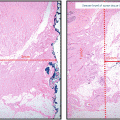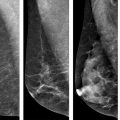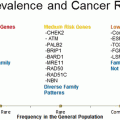Author
Number of patients with DCIS in whom SLN biopsy was performed
Number (%) of patients with positive SLN
Klauber De More [3]
72
5 (7 %)
Wilkie [4]
559
27 (5 %)
Moore [9]
470
43 (10 %)
Veronesi [13]
508
9 (2 %)
Zavagno [14]
102
1 (1 %)
Kelly [15]
41
1 (2 %)
Farkas [16]
46
0 (0 %)
Mittendorf [17]
34
6 (18 %)
Yen [2]
99
3 (3 %)
Cserni [18]
36
4 (11 %)
Mabry [19]
171
10 (6 %)
Katz [20]
110
8 (7 %)
Sakr [21]
39
4 (10 %)
Fraile [22]
92
1 (1 %)
Intra [10]
854
12 (1 %)
When these data were combined in two meta-analyses, Ansari et al. reported an overall 3.7 % nodal positivity rate while van Deurzen et al. similarly reported the nodal positivity as 4 %; both were for patients with a definitive postoperative diagnosis of pure DCIS [23, 24]. The implications of SLN positivity in pure DCIS require further discussion.
From 1996 to 2006, Intra et al. evaluated 854 patients with pure DCIS who underwent SLN biopsy at the European Institute of Oncology [10]. DCIS with microinvasion was excluded. SLN metastases were discovered in 12 out of 854 patients (1.4 %)—a total of 5 patients with macrometastases, 7 patients with micrometastases, and 4 patients with ITCs (pN0i +). Of the 12 patients with SLN positivity, 11 underwent axillary node dissection but none had additional nodal disease. Other studies [2–5, 19, 25] similarly demonstrate lone SLN positivity after formal axillary lymph node dissection. This questions the value of axillary dissection for pure DCIS with SLN positivity particularly in women with micrometastases or ITCs.
Mabry et al. analyzed 564 patients with pure DCIS who underwent either axillary lymph node dissection or SLN biopsy [19]. Only 2 of 564 patients had positive nodal disease, both in the axillary dissection group. These patients were upstaged, underwent mastectomy followed by systemic treatment, and survived beyond 10 years without local or distant recurrence. Six patients in the axillary dissection group had local invasive recurrences and died from metastatic disease; all six had no evidence of nodal disease at the time of axillary dissection. In addition, of the 171 patients who underwent SLN biopsy, ITCs alone were detected immunohistochemically in 10 patients but only 2 of the171 patients had local recurrence and none developed regional or distant recurrence. Consequently, the authors concluded that lymph node status did not predict poor outcome in patients with DCIS. However, lymph node status may predict which primary tumors have the potential to be upstaged. Treatment of DCIS will not influence long-term disease-specific survival which already approaches 100 %; the focus should remain on eliminating invasive local recurrences. Perhaps, this is what a positive SLN means in the setting of DCIS—the patient has a higher risk of having a missed focus of primary invasion, and thus these patients have the potential to be upstaged and systemic therapy should be considered based on biologic subtype of the invasive component.
Even with invasive local recurrences after DCIS excision, outcomes remain encouraging. Lee et al. analyzed 1236 patients previously treated for pure DCIS in order to examine local invasive recurrence, distant recurrence, and breast cancer-specific mortality [26]. There were 150 local recurrences (87 DCIS and 63 invasive). The overall 12-year breast cancer-specific mortality after mastectomy versus breast-conserving surgery was 0.8 and 1.0 %, respectively. Even in the 63 patients with invasive local recurrence, the 12-year probabilities for metastasis and breast cancer-specific death were 15 and 12 %, respectively. Thus, even for the worst prognostic group of DCIS patients (those with local invasive recurrences), a favorable prognosis with minimal evidence of distant disease prevails and is unlikely to prove fatal. Thus, for DCIS, local control should be the ultimate goal; not improving survival which already exceeds 98 %.
Consequences of SLN Positivity in DCISM
When a microinvasive component to DCIS is considered, SLN positivity may increase by up to 17 % [5]. Even though DCIS with microinvasion (DCISM) is a rare pathologic entity (< 1 %), it can be intimately associated with a diagnosis of DCIS [27]. A recent meta-analysis by Gojon et al. evaluated 756 patients in 18 different studies to determine the role of SLN biopsy in patients with DCISM [28]. The authors reported cumulative SLN positivity rates for DCISM of 3.2 % for macrometastasis, 4.0 % for micrometastasis , and 2.9 % for ITCs . Several retrospective studies have evaluated SLN positivity rates categorized to either macrometastatic disease or micrometastatic/isolated tumor cell foci (Table 12.2).
Author | Number of patients with DCISM | % of positive SLN: macromets | % of positive SLN: micromets/ITCs |
|---|---|---|---|
Gray [29] | 77 | 1 (1.3 %) | 5 (6.5 %) |
Sakr [30] | 36 | 2 (5.5 %) | 1 (2.7 %) |
Intra [31] | 41 | 2 (4.8 %) | 2 (4.8 %) |
Katz [20] | 21 | 1 (4.7 %) | 1 (4.7 %) |
Ross [32] | 9 | 0 | 0 |
Takacs [33] | 8 | 0 | 0 |
Ko [34] | 293 | 4 (1.4 %) | 18 (6.1 %) |
Zavagno [35] | 43 | 3 (6.9 %) | 1 (2.3 %) |
Zavotsky [36] | 14 | 1 (7.1 %) | 1 (7.1 %) |
Pimiento [37] | 87 | 4 (4.5 %) | 5 (5.7 %) |
Cserni [38] | 31 | 0 | 2 (6.5 %) |
Meretoja [39] | 34 | 1 (2.9 %) | 6 (17.6 %) |
Klauber-DeMore [3] | 31 | 1 (3.2 %) | 2 (6.4 %) |
Lyons [40] | 112 | 3 (2.6 %) | 11 (9.8 %) |
Le Bouedec [41] | 41 | 1 (2.4 %) | 3 (7.3 %) |
Cserni [18] | 20 | 0 | 1 (5.0 %) |
Guth [42] | 44 | 3 (6.8 %) | 2 (4.5 %) |
The typical diagnosis of DCISM occurs during postoperative pathologic analysis. While the appearance of microinvasion could represent artefactual disruption during processing, patients with DCISM may be recommended a second operation for SLN biopsy [43]. However, Gojon et al.’s meta-analysis challenges this axiom, and there is support to consider that DCISM parallels pure DCIS. Parikh et al. analyzed 393 patients with DCIS/DCISM; of the 393 patients, 72 were diagnosed with DCISM [44]. Axillary evaluation yielded nodal positivity in 1 of 42 patients with DCISM (2.3 %) and 0 of 58 patients with DCIS. In addition, comparing DCIS to DCISM, the authors demonstrated 10-year breast relapse-free survival of 89.0 versus 90.7 % (p = 0.36), distant relapse-free survival of 98.5 versus 97.9 % (p 0.78), and overall survival of 93.2 versus 95.7 % (p 0.95), respectively. Given the analogous relationship between DCIS and DCISM compared with long-term outcomes, patients with DCISM should only be considered for sentinel node biopsy where there is large-size DCIS, palpable tumor, or diagnostic uncertainty.
Consequences of Micrometastatic Disease and ITCs in SLN
Murphy et al. evaluated 322 patients with DCIS or DCISM on final pathology that underwent sentinel node biopsy [45]; of the 322 patients (9.0 %), 29 had positive sentinel node biopsies—18 (5.6 %) identified by IHC alone and 11 (3.4 %) by hematoxylin and eosin (H&E) staining. Of the 29 patients, 25 patients had ITCs, 3 patients had micrometastases, and 1 patient had a macrometastasis. Yet, considering recurrence rates for all 322 patients at 47.9 months, only 1 of 13 local recurrences was SLN positive. This argues against any prognostic significance in terms of local recurrence or survival for micrometastatic/isolated tumor cell sentinel node metastases in DCIS/DCISM .
Moore et al. considered SLN biopsy on 470 patients with high-risk DCIS at three different institutions [9]. Patients were considered high risk if they met the following criteria: palpable or mammographic mass, extensive disease requiring mastectomy, pathology suspicious of invasion, or high-nuclear-grade pathology. Of the 470 patients, 43 (9 %) had SLN metastases—3 (7 %) had macrometastases, 4 (9 %) had micrometastases, and 36 (84 %) had ITCs. Of the 25 patients who underwent axillary lymph node dissection, only one was found to have additional positive nodes. No local recurrences were detected, and only one patient with ITCs in the SLN went on to develop distant metastases at 27 months. However, the authors argue that of the 43 high-risk DCIS patients who were SLN positive, nine patients were upstaged to stage I or stage II and thus went on to receive appropriate systemic therapy. They conclude “that the principal benefit of SLN biopsy to the patient with a definitive diagnosis of DCIS is to identify those with occult invasion.” Finding occult disease in this subset of patients with high-risk DCIS allowed for appropriate staging and adjuvant treatment. Other authors have described this theory of “occult invasion” [2, 46] in DCIS: In an appropriate, high-risk DCIS patient, SLN biopsy serves as a sensitive screening test for areas of missed microinvasion on final histopathology .
Stay updated, free articles. Join our Telegram channel

Full access? Get Clinical Tree







